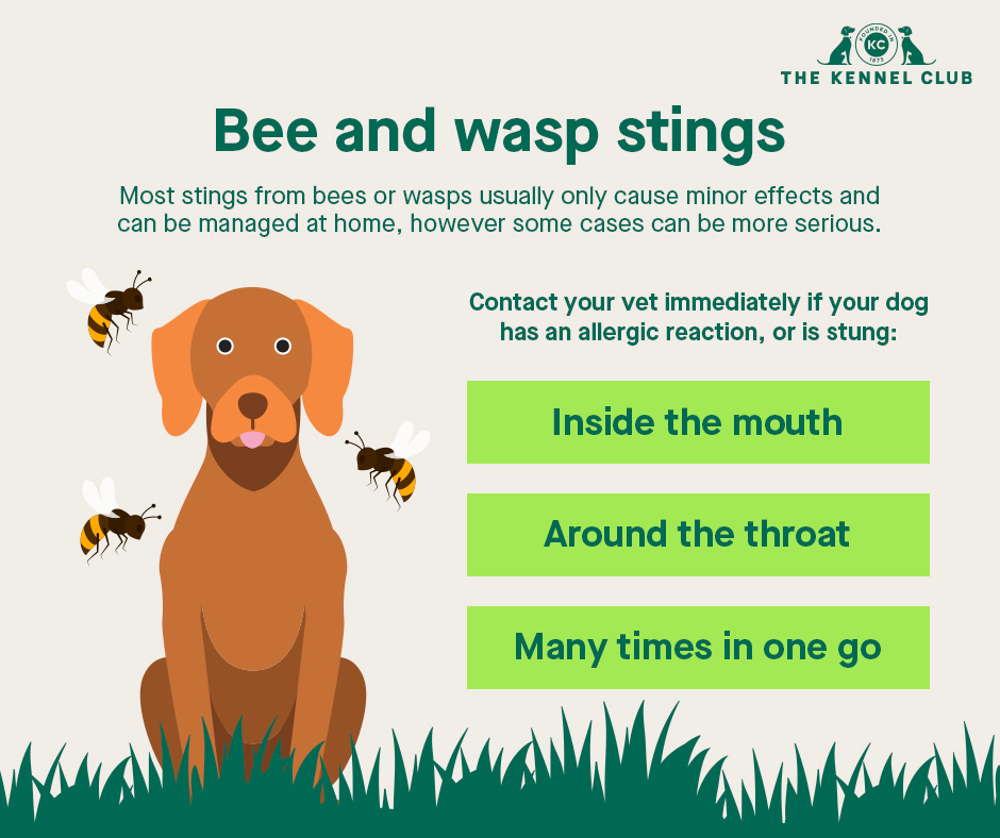
Can bee or wasp stings be dangerous to dogs?
What are the effects of being stung?
Being stung by a bee or wasp could cause your dog to show any of the following common signs:
- Whining
- Agitation
- Swelling
- Lumpy looking skin
- Biting, nibbling or pawing at the place stung
- Drooling
Stings to the paw
Stings inside the mouth
Some dogs may be stung on the tongue or inside the mouth or throat, especially after trying to eat a bee or a wasp. Stings to this area can cause the throat to swell and may block your dog’s airway, making it difficult for them to breathe.
If your dog is stung in the mouth or throat, it’s important that you speak to your vet urgently.
Can dogs have allergic reactions to bee or wasp stings?
Some dogs can be more sensitive to wasp or bee stings and might have an allergic reaction. This can happen quickly (i.e. within 10 minutes) or may be delayed by a few hours. In very rare cases this can be delayed by a day or so.
Signs of an allergic reaction can include:
- being sick or having diarrhoea
- a large amount of swelling around the affected area
- swelling around the mouth and neck (even if not stung there)
- weakness or collapse
- disorientation
- wheezing and breathing problems
If your dog shows any signs of an allergic reaction, it’s important you speak to your vet urgently.
When should I contact my vet?
You should contact your vet for urgent advice if:
- you think your dog is having an allergic reaction
- your dog has been stung in the mouth
- they have been stung multiple times
- the swelling has lasted for several days
- you are concerned about your dog’s health
What should I do if my dog is stung?
How to remove a bee sting
Unlike wasps, bees tend to leave their sting behind lodged in the skin and it continues to pump venom into their victim. If you’re not sure if your dog has been stung by a bee or wasp then make sure you look for a sting. If you find a sting left in your dog then it’s important that you take it out. You can do this by scraping the sting away from the skin, just below the venom sac, using something thin and flat, such as a credit card or a long fingernail.
Don’t try to pinch the sting out with your fingers, or with tweezers, as this can squeeze more of the poison into your dog’s body causing more pain and a larger reaction.
Wash the area
Ease the swelling
Put a clean tea towel under the cold tap, squeeze it out and then hold it against the affected area. This should help to reduce the swelling and will also feel soothing to your dog.
Applying ice will also help, but don’t put ice directly on to your dog’s skin. Place a thin piece of cloth on the skin first and place ice on top of that, or wrap some ice cubes in a tea towel. If you don’t have any ice cubes, then a bag of frozen peas could be used instead. Don’t leave the ice on for too long, just five to ten minutes is long enough.
Can I give my dog antihistamines?
Some over the counter human antihistamines can be given to some dogs, but if you give the wrong drug, or the wrong amount for the size and weight of your dog, it could be dangerous to them.
Only ever give your dog an antihistamine if your vet has told you do so and has told you which antihistamine to give. Only ever give the amount that they suggest is safe.
Keep your dog calm
Keep an eye on your dog
Think your dog may be affected?
If you're worried about your dog's health, always contact your vet immediately!
We are not a veterinary organisation and so we can't give veterinary advice. If you're worried about any of the issues raised in this article, please contact your local vet practice for further information.

